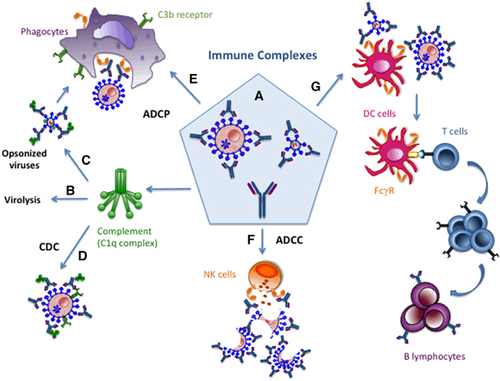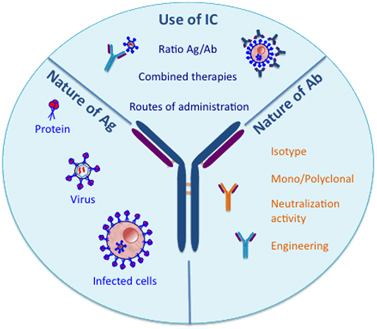Figures & data
Figure 1 Multiple Fc-mediated activities of antiviral mAbs (monoclonal antibodies). Antiviral mAbs can opsonize viruses, as well as infected cells in situations when viral antigens are also expressed on their surface (A). This can lead to viral clearance through various immune-mediated mechanisms. The Fc domain allows the binding of complement to free virions, inducing direct virolysis (B). Fcγ- and complement receptors can recognize opsonized virions, leading to their phagocytosis by cells of the innate immune system (C). Infected cells can also be eliminated by complement-dependent cytotoxicity (CDC), antibody-dependent cellular phagocytosis (ADCP) and/or antibody-dependent cell-mediated cytotoxicity (ADCC) mediated by innate immunity effector cells expressing FcγRs (D–F). Immune complexes (ICs) made with mAbs and different viral determinants (virions or infected cells) can be recognized by FcγRs expressed on antigen-presenting cells such as dendritic cells (DCs) (G). IC recognition by DCs subsequently leads to enhanced antigen uptake and presentation, allowing the induction of stronger antiviral immune responses.

Table 1 In vitro studies of T-cell responses modulation by IC-activated DC
Figure 2 Parameters to consider for achieving optimal IC-mediated modulation of antiviral immune responses. The optimization of vaccine-like-effect-inducing protocols will require the consideration of several parameters such as the nature of the antigen (that is, purified viral proteins, whole virions and infected cells) and the antibody (that is, monoclonal vs polyclonal, nature of the isotype, engineered Fc domain with improved effector functions and so on) used to form the immunogenic ICs, as differences in these parameters might impact immunological outcomes. In addition, whether the optimized ICs are used alone or in combination with immunostimulatory molecules might also be of paramount importance. Several other parameters, including the IC dosage, the route of administration, the choice of adjuvant and the immunological status of patients, will also have to be considered.

